I’m here today to write about Chavez Ravine, which is not on Bunker Hill, true, but their stories share commonalities: postwar government says “we know what’s best for you” and seizes property, removes the residents, and redevelops. There are countless instances of this in Los Angeles’ history, but in the case of Chavez Ravine, it has become one of Los Angeles’s best loved, deeply hated, and most oft-repeated stories. This is the first installment of a seven-part series (links to the other entries are found at the bottom of this post).

I. The Mainstream Narrative
Everything you think you know about Chavez Ravine? All that stuff about how the racist developers illegally evicted the poor and gave them no compensation for their homes so they could build Dodger Stadium?
It’s not true. But hey, it’s not your fault you believe that. You’ve been fed a steady diet of untruths—a mixture of urban legend, conspiracy theory, manipulated facts, confirmation bias, and outright nonsense.
Let’s say you Google “Chavez Ravine.” First thing is gonna be the Wiki page, obviously, but then the very next two are a couple of endlessly-shared-on-social media articles from the LAist and Howard Zinn.
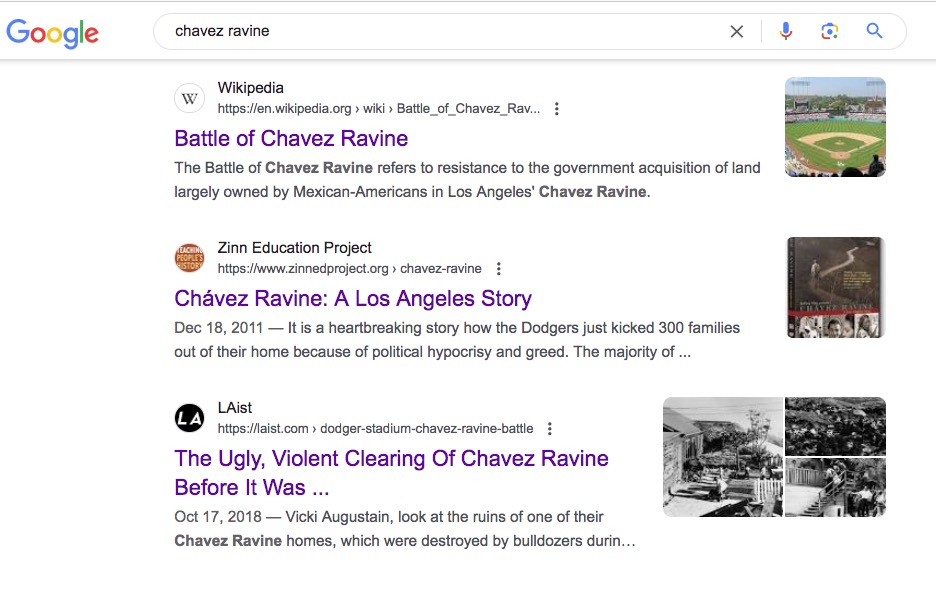
The Wiki page gets some of the broad strokes correct (but, being Wikipedia, still contains some whoppers); the other two, though, consist of lie after lie after lie.
Ok, maybe it’s heavy-handed to say everyone in the media is consciously lying to you. Maybe they just didn’t know any better, having heard some things and simply regurgitated it all into their keyboards, with all the best intentions. It happens all the time to journalists who are told some nonsense, which—if it makes them feel good and righteous to believe said nonsense (yay, confirmation bias!)—they report it verbatim without fact-checking, because why not? Fact-checking is so old-fashioned! Perhaps the mainstream narrative is more diplomatically termed “consists of disinformation” rather than “is composed of outright lies” but no matter, a tumult of falsehoods is still a tumult of falsehoods.
Don’t believe me? Let’s look at what they write!
First up, this piece in the LAIst:

It begins:

The first sentence is clunky and ill-crafted (the stadium itself was known as Chavez Ravine…before it had baseball? or before it was legendary? huh?) but that’s not the issue. The issue is the oft-repeated canard that it was “home to generations of families,” when in fact most people in the area moved there in the late 1920s and were gone by the early 50s…with the average family stay in in Chavez Ravine being 25 years, that’s not “generations,” that’s ONE generation. (I’ll concede a generation-and-a-half for those few who colonized the area in the 1910s.)
The LAist article continues:

A patent untruth. The Housing Authority of the City of Los Angeles, they and they alone, used eminent domain to wrest the land away from its owners, years before the Dodgers even thought of ditching Brooklyn. (Though I’m intrigued by the sinister-sounding “other political machinations”…I’m sure those won’t end up being a fantasy, right?)
Then:

The forced sale of homes by homeowners to the City—homeowners who then purchased property elsewhere—I would, too, describe as ugly, because eminent domain was and is always an ugly thing for the Housing Authority to do (as they did and still do) in the name of “the common good.” The only violent part, though, was the one woman who insisted on being carried out, six years after her parents no longer legally owned the home (and it could be argued the violence was hers, given as she was arrested for punching and kicking deputies).
And if it’s the sort of history that Los Angeles residents “don’t like to remember,” how come EVERY other day Los Angeles residents will put yet another post on social media about it? With innumerable comments thereafter? To be more accurate, it’s the ONLY history Los Angeles residents like to remember.

Oh dear, this goofy canard. The purchase of homes by the City (or, as Ms. Shatkin mysteriously calls the City, “developers”) was handled through a public agency in collaboration with the courts—whereby three separate city appraisers would appraise a house, and the court would award the highest of the values. Eminent domain condemnations in Chavez Ravine were handled the same way that thousands of other homes had been taken: for civic buildings, schools and fire stations, freeways, and most analogous to Chavez Ravine, for the many public housing projects Los Angeles had constructed both before and after WWII.
The “they lowballed homeowners” compounded by “you better sell now because if you don’t we’ll give you less later” would have been a huge story of City malfeasance and we would have heard about it, had there been any evidence of this “tiered buy-out scheme that offered increasingly lower amounts to sellers who stalled” business among the many primary sources. It is, however, a fiction. There are a number of sites that attribute the story to Mike Davis. Here’s a standard retelling of the myth:

And yet, should you actually read Davis’ City of Quartz you will find no mention of the story.* It is a tale that seems to have been invented in the last decade, and despite being repeated multiple times, in articles and in books (most recently in Bruce Bertrand’s One Town, One Team) it has never been attributed to anyone, for there are no primary sources nor are there any contemporary accounts. When you consider it was never mentioned in interviews of Chavez Ravine residents, or was a point of contention in the 1953 House of Representatives hearings investigating Public Housing in Los Angeles, or was referred to by angry anti-government/anti-Dodgers newspapers like The Torch Reporter (which also gave voice to angry Chavez Ravine residents, who vented at length and never mentioned such a thing)…we may therefore safely assert the story is fiction. That the apparent earliest extant reference to the idea is from Shatkin’s blisteringly fact-challenged October 2018 article leads us to believe she is its source. I’m not saying she made it up, necessarily; my guess is she was told tales and accepted them as gospel (journalistic ethics being so terribly démodé).
In case I’m not being clear, please allow me to repeat. When you see this in Wikipedia:
…remember, you are being lied to. You are being lied to by agenda-pushing lying liars. Maybe when some idiot added this nonsense to the Dodger Stadium Wiki page, they were merely…mistaken. But the next paragraph about “developers” trying to “create a community panic” is such absolute fantasy, it could only be the product of contemptible con artists. If you’re interested in this topic, I go on a little bit more about it here and here.
*I am indebted to bunkerhilllosangeles reader zhandoatosl for calling this to my attention.
**********
Our next example is from the wacky world of Howard Zinn. Who’s Howard Zinn? He was a “historian,” but who famously said history is “not about understanding the past,” but about “changing the future.” Which is adorable, but no actual historian would ever say such a thing. (You think I’d like Zinn, as he’s basically the twin of my beloved father.)
Zinn has become the dominant narrative because he is taught in every classroom, up to and including the Zinn Education Project; you know, for kids! Let’s look at something about Chavez Ravine from the Zinn Education Project:
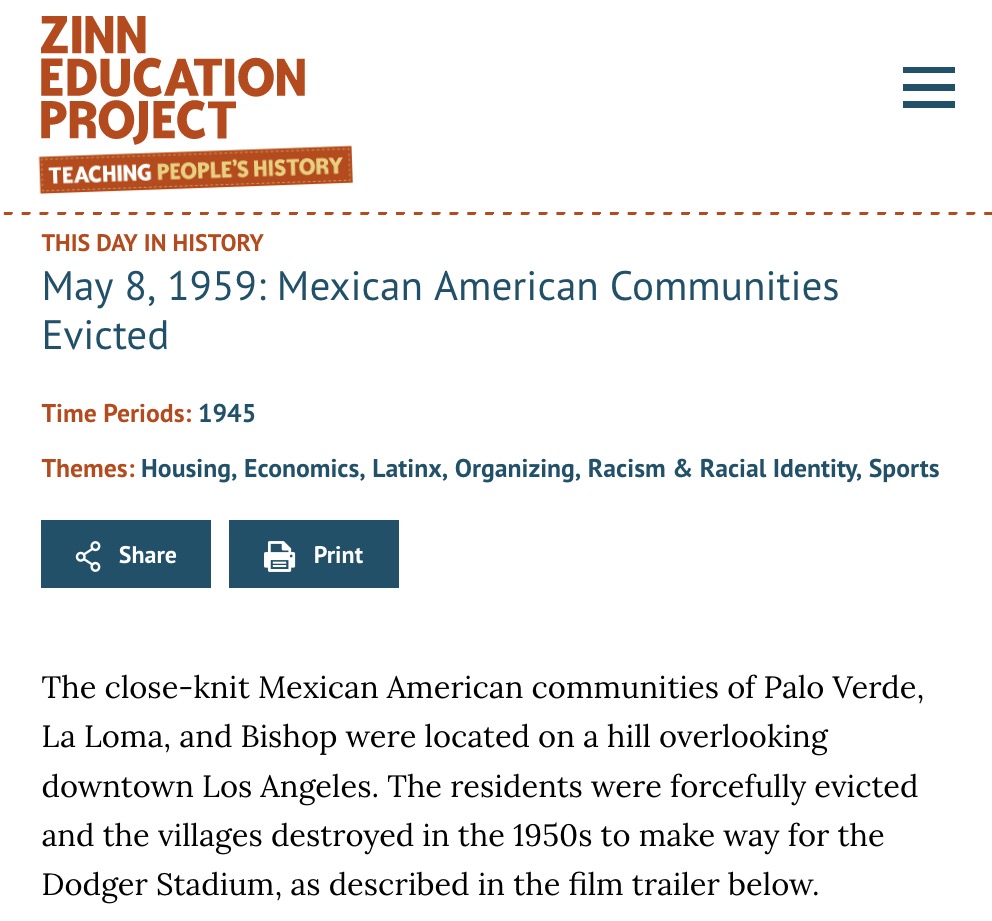
Forcefully evicted? To make way for Dodger Stadium? Do you mean…had their homes legally purchased by the leftist Housing Authority to build public housing? (And regarding the article’s title, the number of “Mexican American Communities” evicted on May 8, 1959 was…one family.)

Again with this “generations” business when only one generation of people ever lived in the area (again, maybe a generation and-a-half when counting the few people who got there really early, like 1915). But, 1840s??? There weren’t enough people there to make anything resembling neighborhoods until the 1920s. Neighborhoods which, I might add, were not “founded.” The area had been subdivided with one of the tracts named Palo Verde, which lent its name to the area. La Loma and Bishop were nicknames for certain areas, atop which, many people disagree as to what areas those neighborhoods actually encompassed.
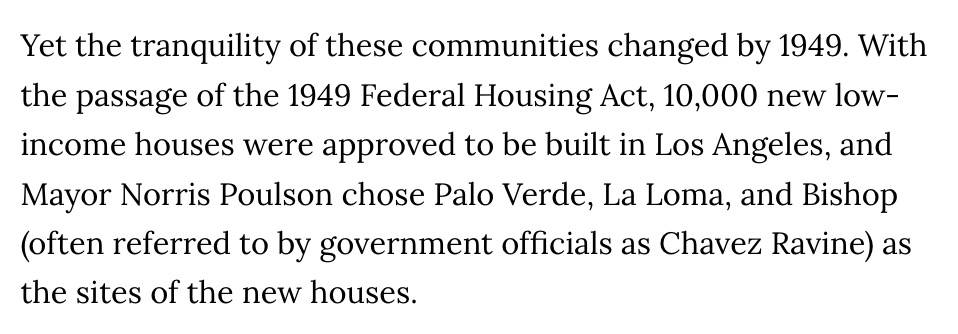
“Mayor Norris Poulson chose Palo Verde, La Loma and Bishop”? Oh dear, noooo. It was the Health Department that “chose” the area for redevelopment. It was then the Housing Authority who agreed with the Health Department’s findings and began clearing the land. And who was mayor? Liberal pro-housing mayor Fletcher Bowron. 1949-1952, the years of Chavez Ravine’s demolition, Bowron was mayor; Norris Poulson didn’t even live in Los Angeles! Poulson was in Washington DC, serving as our Congressman, until elected mayor in 1953. (And as we shall see, those three neighborhoods were known as Chavez Ravine by everyone, not just those pernicious government officials.)

Nothing was built on those communities, because the Housing Authority erased those communities from the landscape years before the baseball stadium idea existed.
And no, the residents did not “fight until the end as a unified resistance group.” The residents had all cashed their checks and bought new places elsewhere. All, of course, except for one family—the famed Arechiga clan, about whom we will hear much more later—who said they would leave if only the City coughed up another $7,000. But because the City knew if they bowed to the monetary demands of any homeowner when it came to Eminent Domain, it would set such a bad precedent, that no school or road or fire station would ever be built again, so they held fast. (There was a small collection of other homeowners who individually got more money for their land, because they followed proper channels and filed appeals on their home valuation—a process the Arechigas refused to do.)

HA HA HA HA ok this one’s really good. Wilkinson didn’t “come to the defense of the families”! Frank Wilkinson was literally the man who kicked out all those poor people! And what does his being jailed have to do with it? To be historically accurate, this sentence would read, “The representative from the L.A. Housing Authority who came to kick all the poor people the hell out, Frank Wilkinson, was targeted and jailed by the House Un-American Activities Committee (HUAC), six years later, in Atlanta, for something totally unrelated.”
Lets look at one more Zinn-ism:

“Given no compensation for their displacement…” Dear lord. Listen up: every citizen was given not only fair market compensation by the Superior Court but because of State Law they were awarded higher than fair market. Of all the many fantasies promulgated about Chavez Ravine, the whole “no compensation” myth is probably the most pernicious and oft-repeated. Here is PBS, whom you think would know better, saying “The residents of Chavez Ravine, who had been promised first pick of the apartments in the proposed housing project, were given no reimbursement for their destroyed property and forced to scramble for housing elsewhere.”
To quote the California Law under which Chavez Ravine homeowners were compensated (under enormous and repeated scrutiny I might add), “the owner must be paid the highest price which the land will bring if exposed for sale in the open market.” There was no ceiling on the money paid either, and in fact, appraisals and thus monies paid often ran above assessed valuation, because, the court had to do three appraisals on each property and were then mandated by law to pay the very highest appraisal. Ok? Ok.
And regarding Zinn’s contention Chavez Ravine residents were “forced to flee” (the most mendacious and overwrought bit of alternate history I’ve ever read) and PBS’ contention homeowners were “forced to scramble,” no, the City of Los Angeles opened an office in Chavez Ravine specifically dedicated to the relocation of residents. Before anyone could leave, renters were matched with new apartments, and homeowners were found new homes. The office was managed by Vicki Alonzo, who managed files on all residents regarding their wants and needs (Miss Alonzo was fresh off the task of finding new homes for the 652 residents displaced by slum clearance in 1949-50 as part of the Bunker Hill Civic Center expansion). It was city, state, and federal law that individuals and families removed for redevelopment had to immediately be found new homes.
II. Goofy Untruths=A Reparations Bill
I think by now you get the point: look up Chavez Ravine, and expect to be subjected to a cavalcade of disinformation.
Chavez Ravine made the news recently when, last month, Assemblywoman Wendy Carrillo introduced Assembly Bill (AB) 1950, the Chavez Ravine Accountability Act. A reparations bill, it seeks to give more money, and property, to descendants of those who sold their homes in the early 1950s. The text of the bill is here. It has passed in the assembly.
I’ve no qualms with government payment being made to redress government wrongs. I *certainly* applaud the effort in the bill to erect a memorial to La Loma, Bishop, and Palo Verde, which is something I was talking to politicians about 25 years ago!
The problem is, this bill is largely based on false premises. Whoever wrote this thing for Carrillo fell for all the typically inaccurate material one lazily culls from the internet. For example:

If the residents were unjustly removed, then every person removed for a freeway, school, fire station, public housing, and urban renewal was also similarly and equally unjustly removed. More importantly, “removed without proper compensation?” Again, each home valuation was set by three government appraisers and then it went to the court and the court would assign the highest valuation. That’s a matter of historical record, but nice to see the City has no fact-checkers when it comes to things that were literally done by…the City.

“More than 1,800 families?” I’m sorry, WHERE do you get that number? The Feds counted the number of families in the greater area in 1950, at the very height of its population: 1,086 families, and that counted all of Solano Canyon, which still stands, also along Bishops road near Broadway, and the part along what’s now Stadium Way of Bernard and Cornel. Thus the actual number of displaced families numbered no more than about 700.
The 700 number is tough to swallow, too; if you count the total number of structures in La Loma, Palo Verde and Bishop (Sanborn maps, aerial photography) they number about 350. Now assuming that EVERY one of those structures was a house (a strange world where Chavez Ravine did not have a single garage or workshed or chicken coop or whatever), EVERY structure would have had to have had two families living in it, in a land of mostly small single family homes? A quick check of the census shows very, very few addresses having more than one family. Before this “1,800 families” number came out of nowhere, the accepted number was 300. The 300 number is the accepted number, given the vast number of places it is cited.

Remember, this “racially motivated property seizure” was done by progressives who were hot for slum renewal, and who displaced everyone. It happened not just in Chavez Ravine, but all over Los Angeles, and, of course, across America—e.g., New York’s Lincoln Square project displaced 4,400 families (who, FWIW, numbered at 93% white); LA’s Temple Area project removed 1,600 families (87% white); Boston’s West End project, 3,000 families displaced (99% white), etc. etc. I’m not saying the American Left wasn’t in general suuuuper awful and often racist in their paternalistic “the government knows what’s best for poor people” attitude, but in Chavez Ravine’s case there’s zero evidence they did it due to any racial animus. The land was chosen for redevelopment on the recommendation of a lengthy and detailed report by the Health Department, which does not see race, but rather statistics about indoor plumbing, vermin infestation, disease rates, and the safety of housing construction.
The lands were not “sold below market value against the will of the landowners” because the landowners received market value, and if receiving their money was against their will, then, how would that have made them different from countless other government projects wherein the same thing happened? Of the “1800 families” (300 families, if even that) 99% had cashed their checks and moved elsewhere by 1953. Land titles were not “returned to the owners” because they had cashed their checks and moved on years before. One family sued to regain title, by reversing condemnation, because public housing had been abandoned. The courts rejected the suit, holding that once title had passed to the city, the transaction could not be undone (Arechiga v. Housing Authority of City of Los Angeles, 159 Cal. App. 2d 657, 659-60 [1958]).
“By 1958, the Elysian Park Heights housing project had unraveled…” yes, “by” 1958 it had unraveled, because it finished unraveling in 1953. The City spent five years thereafter attempting to find a use for it (cemetery, zoo, lake, even Disneyland’s original location were in the running).
“The city conveyed the land to a private entity for an insignificant amount considering the land’s value.” This is so willfully dumb it’s hard to believe, and I’ll go into this claim in detail in Part V. In short, though: we deeded the land to the Dodgers, and it had its value assessed by City property appraisers at about $2million, and in return, the Dodgers deeded the City land worth about $2million, so basically an even swap. BUT then the Dodgers built the stadium out of their own pocket which (adjusted for inflation) cost them a quarter of a billion dollars. Thereafter, where the City once got next to nothing in property taxes from Chavez Ravine, we have since had over a billion dollars in property taxes paid into City coffers by the Dodgers, not to mention the jobs and other taxes the ballpark has provided us.
Oh, and the city bulldozed and buried Chavez Ravine…cemeteries? Are you attempting to refer to the Jewish cemetery that the Hebrew Benevolent Society dug up and moved to Home of Peace in Whittier, or the Roman Catholic Calvary, whose dead were disinterred and moved to New Calvary? Because those cemeteries weren’t near La Loma, Bishop or Palo Verde and what’s more, they were all moved out before those were even neighborhoods. (And what was “buried?” Please don’t tell me you mean that wholly-debunked “they buried a school” nonsense.)

Sigh. Again, I will go into this in the forthcoming posts, but no, no, and no. If you throw around words like “wrongfully” and “unjustly” and “fraudulent” you are going to need to prove your case. Which you can’t, because you’re just cut-and-pasting inflammatory buzzwords.
In short—and bear in mind I’m not a fan of eminent domain in the least, but that notwithstanding—it is an inarguable truth that Chavez Ravine was condemned legally, everyone was paid, nothing was fraudulent, and again, there’s zero evidence it was done on the basis of race. Hard to believe AB1950 would assert something unconstitutional happened, when for years the whole process was debated by the courts, up to and including the Supreme Court; it was debated at length, and voted on by City Council; the entire matter went before the the citizens, who voted on it in the polls, twice; the project was supported by Mexican-American civic organizations and powerful concerns like the unions and leftist civic groups; certainly someone along the way would have noticed wanton wrongful fraud resulting in an unjust deprivation of constitutional rights. (Actually, anti-Communist conservatives went to bat for the people of Chavez Ravine for their “inalienable right to control one’s property,” but guess what, nobody listened to them.)
III. The Good Parts of AB1950
Mind you, not everything in AB1950 is just lists of well-meaning but easily disprovable claptrap lazily gleaned from the internet. I did, for example, really like this part:
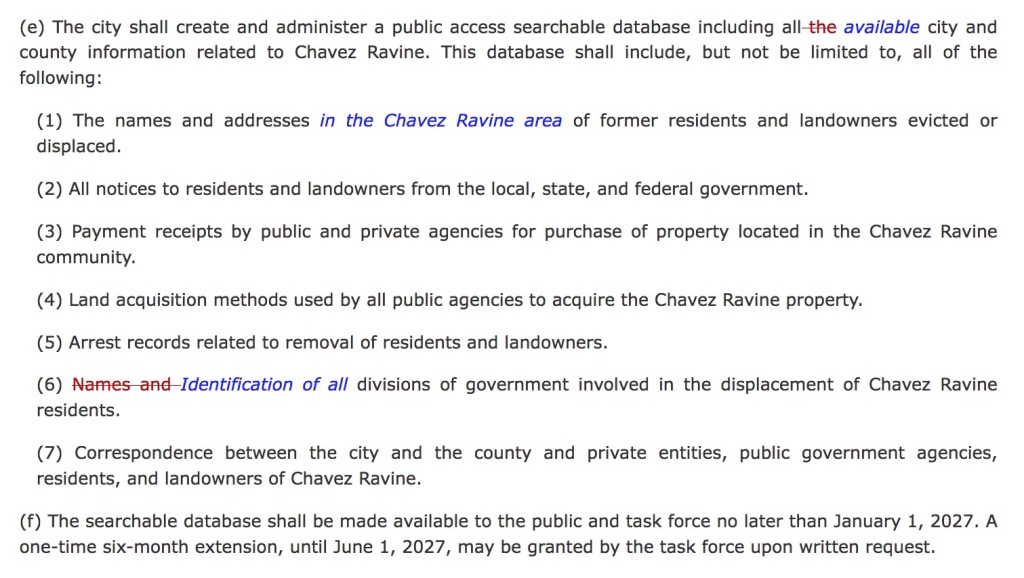
This would be an incredibly valuable database (it would also put to rest persistent untruths like “families were left destitute,” a constantly-repeated bit of disinformation repeated by, for example, Wendy Carrillo…oh, and the Bill repeats this falsehood as well).
This database will be valuable to all involved IF, and only if, it is compiled by someone who can accurately navigate the primary source material and fastidiously evaluate the secondary. For this project to fly, it is imperative the City hire a professional historian with a background in the topic. My advice? Hire me. That’s right, City of Los Angeles, get me on board and I’ll produce your database and it will actually be correct. Trust me, you want this to be correct, otherwise you’ll end up paying out monies to people who don’t deserve them. Said monies are said to be in the “tens of millions of dollars” at minimum, which is a tall order considering the city’s nearly half-billion-dollar deficit. Ergo, let’s get it right.
Lastly:

That would be awesome, and again, something I used to press politicos for when I first got obsessed with Chavez Ravine back in the mid-1990s. Onward!
This, then, has been the general introduction to the topic of Chavez Ravine. All the matters I touch on, above, will be covered in greater depth in the posts to follow. I will post a new chapter every two days:
Part I: Chavez Ravine and the Mainstream Narrative Published Friday, May 10.
Part II: What is Chavez Ravine
Its beginnings, development, and evolution to 1950; its history of demolition prospects; and, can you call it Chavez Ravine? Published Sunday, May 12.
Part III: Calm Before the Storm
A snapshot of life in the area in the 1940s. The mythos of small-town life; Normark’s documentary work; a study of the people of Chavez Ravine; churches, markets, bus lines, etc. Published Tuesday, May 14.
Part IV: The Rise and Fall of Elysian Park Heights
A history of public housing; Neutra’s Elysian Park Heights project; its proponents and opponents; the area’s demolition; the downfall of public housing, and its relationship to anticommunism; land use after the demolition and nullification of the contract. Published Thursday, May 16.
About the Dodgers; what constitutes public purpose; an illegal backroom deal?; a stadium is built. To be published Monday, May 20.
The Arechiga family history to 1950; eviction from Malvina Street; eventual removal in May 1959; the multiple Arechiga houses; life after Malvina; the next generation of Arechigas. To be published Thursday, May 23.
Part VII: In Summation, plus Odds and Ends
Key takeaways; plus a collection of *other* commonly-held beliefs about Chavez Ravine, conclusively debunked. To be published Monday, May 27.
And don’t forget to read:
A web series does an episode about Chavez Ravine, and everything in it is untrue.
Deflating More Chavez Ravine Nonsense
A podcast does an episode about Chavez Ravine, and gets it all wrong.
If you have comments or corrections, please don’t hesitate to write me at oldbunkerhill@gmail.com.
And don’t forget to give us a follow on the Instagram!
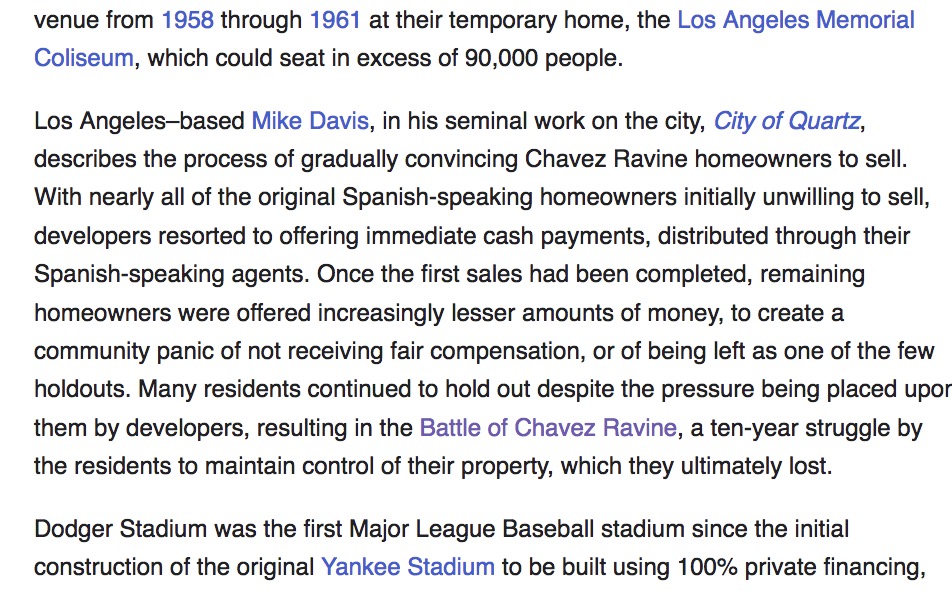
This is terrific, Nathan.I wait with bated breath for part 2.Leslie
LikeLike
Keep this up, and you’ll need to rename your blog: Debunker Hill, Los Angeles
LikeLike
Nathan, I oppose AB 1950 and will continue to do so as it moves thru the State Senate. My family took the monies they received and moved to Stone Street in City Terrace and on 4th Street in East Los Angeles. Here is my letter to the Assembly Appropriations Committee.
LikeLike
I believe what you printed
LikeLike